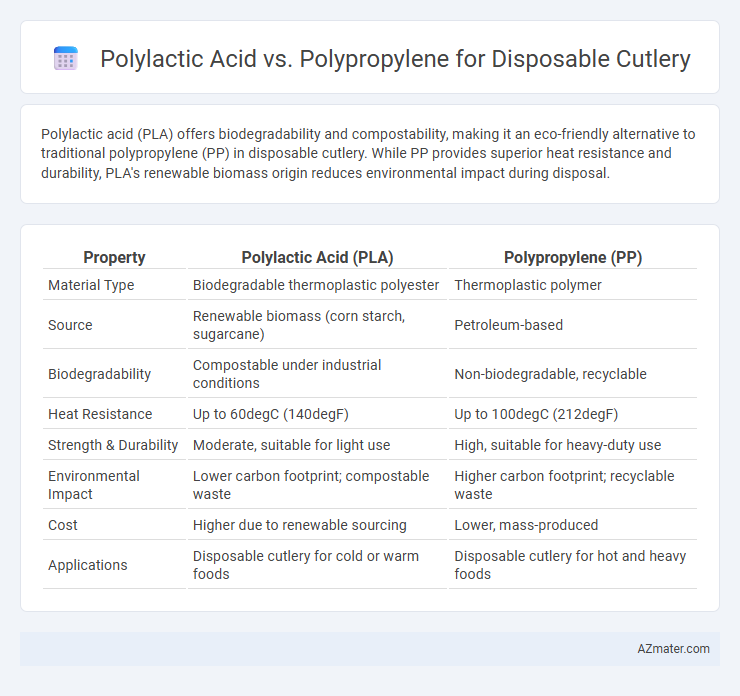Polylactic acid (PLA) offers biodegradability and compostability, making it an eco-friendly alternative to traditional polypropylene (PP) in disposable cutlery. While PP provides superior heat resistance and durability, PLA's renewable biomass origin reduces environmental impact during disposal.
Table of Comparison
| Property | Polylactic Acid (PLA) | Polypropylene (PP) |
|---|---|---|
| Material Type | Biodegradable thermoplastic polyester | Thermoplastic polymer |
| Source | Renewable biomass (corn starch, sugarcane) | Petroleum-based |
| Biodegradability | Compostable under industrial conditions | Non-biodegradable, recyclable |
| Heat Resistance | Up to 60degC (140degF) | Up to 100degC (212degF) |
| Strength & Durability | Moderate, suitable for light use | High, suitable for heavy-duty use |
| Environmental Impact | Lower carbon footprint; compostable waste | Higher carbon footprint; recyclable waste |
| Cost | Higher due to renewable sourcing | Lower, mass-produced |
| Applications | Disposable cutlery for cold or warm foods | Disposable cutlery for hot and heavy foods |
Introduction to Disposable Cutlery Materials
Polylactic acid (PLA) and polypropylene (PP) are predominant materials used in disposable cutlery production, each offering distinct environmental and performance characteristics. PLA is a biodegradable bioplastic derived from renewable resources like corn starch, making it a sustainable choice for eco-conscious consumers. Polypropylene, a petroleum-based plastic, is favored for its durability, heat resistance, and cost-effectiveness but poses challenges in biodegradability and recycling infrastructure.
What is Polylactic Acid (PLA)?
Polylactic acid (PLA) is a biodegradable thermoplastic derived from renewable resources such as corn starch or sugarcane, making it a sustainable alternative to petroleum-based plastics like polypropylene. PLA exhibits excellent clarity and is compostable under industrial conditions, reducing environmental impact in disposable cutlery applications. Its lower melting point and rigidity make it suitable for lightweight utensils, while offering reduced carbon footprint compared to traditional polypropylene.
What is Polypropylene (PP)?
Polypropylene (PP) is a thermoplastic polymer widely used in disposable cutlery due to its durability, heat resistance, and low cost. It is derived from petroleum and features excellent chemical resistance, making it suitable for food contact applications. Unlike polylactic acid (PLA), PP does not biodegrade easily, contributing to environmental concerns associated with single-use plastic waste.
Environmental Impact: PLA vs PP
Polylactic acid (PLA) is a biodegradable polymer derived from renewable resources like corn starch, offering significant reductions in carbon footprint and landfill persistence compared to polypropylene (PP), which is petroleum-based and non-biodegradable. PLA decomposes under industrial composting conditions within months, minimizing long-term environmental pollution, whereas PP can persist for hundreds of years, contributing to plastic pollution and microplastic formation. However, the environmental benefits of PLA depend on proper composting infrastructure, while PP's widespread recyclability is limited by contamination and collection challenges.
Biodegradability and Compostability Comparison
Polylactic acid (PLA) is a biodegradable and compostable bioplastic derived from renewable resources like corn starch or sugarcane, breaking down through industrial composting within 60 to 90 days under controlled conditions. Polypropylene (PP), a petroleum-based plastic widely used in disposable cutlery, is not biodegradable and can persist in the environment for hundreds of years, posing challenges for waste management. PLA offers a sustainable alternative to PP by effectively reducing landfill waste and supporting circular economy goals when disposed of in industrial composting facilities.
Strength and Durability Differences
Polylactic acid (PLA) disposable cutlery offers moderate strength but lacks the high durability found in polypropylene (PP), often breaking under pressure or prolonged use. Polypropylene cutlery exhibits superior impact resistance and flexibility, making it more reliable for heavy-duty applications and repeated use. While PLA is biodegradable and environmentally friendly, polypropylene's enhanced mechanical properties provide longer-lasting performance in disposable utensils.
Heat Resistance and Performance
Polylactic acid (PLA) offers moderate heat resistance, typically up to 60degC (140degF), which limits its use in hot food applications, while polypropylene (PP) withstands higher temperatures around 120-130degC (248-266degF), making it suitable for both hot and cold disposable cutlery. PLA's biodegradable nature supports environmental sustainability but may compromise performance under heat, often resulting in deformation or reduced rigidity. Polypropylene combines durability and superior heat resistance, maintaining structural integrity during use, yet poses challenges in biodegradability compared to PLA.
Cost Comparison: PLA vs PP Cutlery
Polylactic acid (PLA) cutlery typically costs 20-30% more than polypropylene (PP) due to its renewable sourcing and biodegradable properties. PP cutlery benefits from lower raw material and production expenses, making it the preferred choice for budget-conscious bulk orders. Despite the higher price, PLA's eco-friendly advantages often justify the investment for businesses targeting sustainable product lines.
Consumer Safety and Food Contact Regulations
Polylactic acid (PLA) cutlery offers enhanced consumer safety due to its biodegradable nature and ability to meet strict food contact regulations such as FDA 21 CFR 177.1520 and EU Regulation No 10/2011, ensuring it is free from harmful chemicals and safe for hot and cold food use. Polypropylene (PP) cutlery, widely used for disposable cutlery, complies with similar regulatory standards and boasts high chemical resistance and thermal stability, minimizing risks of leaching harmful substances into food. Both materials must be rigorously tested for migration limits and compliance with food contact legal frameworks to guarantee consumer protection during use.
Which Material is Better for Disposable Cutlery?
Polylactic acid (PLA) offers superior biodegradability compared to polypropylene (PP), making it an environmentally friendly choice for disposable cutlery with its compostable properties derived from renewable resources like corn starch. Polypropylene provides greater durability, heat resistance, and cost-effectiveness, which ensures reliable performance in both hot and cold food applications. Choosing between PLA and PP depends on prioritizing sustainability with PLA or durability and affordability with PP for disposable cutlery production.

Infographic: Polylactic acid vs Polypropylene for Disposable Cutlery
 azmater.com
azmater.com